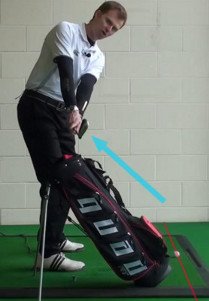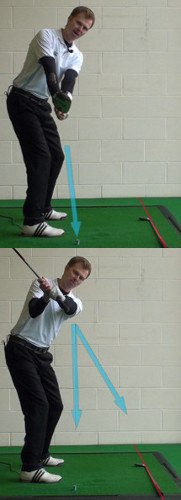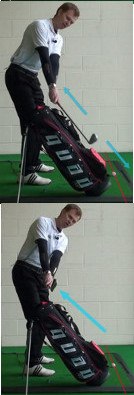
There are many ways to describe the plane of the golf swing, but the simplest may be this: A swing that's “on plane” follows the same angle as the club's shaft when its sole rests flat on the ground.
There are just as many ways to check and practice your swing plane. Some involve multiple props, like long rods that must be stuck in the ground at proper angles. As luck would have it, most golf stand bags lean at the same angle as a 6-iron of standard lie. (To check yours, simply place the club so that its sole lies flat and position it next to your bag in the standing position. If the 6-iron doesn't match, see if another club does.)
On the driving range:
- Place the bag behind you so the bottom is lined up with the ball (target line).
- With the appropriate club, make your backswing – the shaft's path should match the angle of the bag.
- Repeat the drill with the bag on your left side to check the plane of your through-swing.
If you hit the bag at any point, your swing is too flat (horizontal). If the club points at a more upward angle than the bag, you are too upright (vertical).

Swing On Plane with Stand Bag Drill
Keeping your swing on plane is one of the best things you can do for your game as a whole. While it is possible to hit some decent shots while using an off plane swing, it certainly isn't recommended. Swinging off plane will require some last-moment hand action to square up the face of the club, and those kinds of adjustments are always going to be difficult to execute. A far better bet is to keep the club on plane from start to finish. This is the kind of swing you usually see on the PGA Tour, as it produces consistent results, even under pressure.
It probably isn't a surprise to hear that swinging the club on plane is not an easy task. There are plenty of moving parts in the golf swing which need to be coordinated in order to bring the final product together properly. If anything goes wrong along the way, the club may be moved off plane – and it is unlikely that you will be able to recover before striking the ball. Simplicity is your friend in golf as it helps you repeat your action time after time. Making your swing as simple as possible by keeping the club on plane throughout the action needs to be one of your top priorities.
In this article, we are going to help you keep your swing on plane by offering up a simple but effective drill. If you are willing to use this drill from time to time on the driving range, you will find that it is a big help as you try to pull your swing together properly. In fact, you may decide to use this drill on an ongoing basis – even for just a few swings per practice session – to help you stay on track as the months and years go by.
To perform this drill, you are going to need a 'stand bag'. As the name would indicate, this is a golf bag which has a stand that deploys when it is set on the ground. These types of bags are extremely popular with those who walk the golf course for most rounds. The stand makes your clubs easy to access, it prevents you from having to bend over to pick the clubs up off the ground, and it keeps your bag out of the dirt and the dew. Even if you only walk the course from time to time, having a stand bag available in your collection of golf equipment is a good choice.
All of the content below is based on a right-handed golfer. If you happen to play left-handed, please take a moment to reverse the directions as necessary.

The Benefits of an On Plane Swing
To provide you with some much-needed motivation before you head out to work on your swing, we are going to take a moment to discuss the potential benefits of an on plane swing. If you are like most amateur golfers, you probably haven't thought much about the plane of your swing in the past. You are too worried about just trying to get the ball off the ground and moving toward the target to care about your plane. However, by investing some time and effort into improving your swing plane you should be able to elevate the level of your game as a whole.
The list below includes some of the key benefits to be enjoyed when swinging the club on plane.
- Hitting your target line time after time. Despite the obsession that many golfers have with distance, golf is a target-based game first and foremost. If you can hit the ball on line with your targets over and over again, you are going to fare quite well – even if you aren't the longest hitter on the course. There are plenty of 'bombers' on the PGA Tour these days, but there are also plenty of pros who hit it shorter and make their money on accuracy. Swinging the club on plane is going to help you hit your targets more frequently, and such an improvement will naturally lead to lower scores.
- Improved power thanks to freedom. When you swing the club down into the ball on the right plane, you won't have to worry about making any last moment adjustments before impact. Since everything will be on track toward a successful impact, you can turn the club loose and focus on maximizing power. Players who aren't quite on plane as they swing down are often too worried about guiding the club into the ball correctly to really rip the club head through the ball. Once you get yourself on plane, you will no longer need to worry about any adjustments at the bottom. You will be able to trust your swing while letting every last bit of power transfer into the golf ball.
- Holding up under pressure. One of the things that makes golf so hard is the fact that you will feel pressure frequently when on the course. It doesn't matter if you are playing in a big tournament or playing a solo round with nothing on the line – pressure can always find you in this game. Most of the pressure in golf is internal, as you will put pressure on yourself to perform at a higher and higher level. For instance, it is common to get nervous late in a round if you have a chance to set a personal best score. Or, you might feel tight before attempting a difficult shot over a water hazard. No matter where the pressure happens to come from, it is important to manage that pressure effectively through the use of a reliable swing. With a swing that is on plane every time, you should be able to hit your targets even if the butterflies are in full flight in your stomach.
- A playable ball flight. Players who swing the club off plane and manage to manipulate it into position at the last moment may be able to get away with that kind of swing from time to time, but the ball flight will always be 'ugly'. If you have to use a dramatic curve to get your ball to the target, you are setting yourself up for failure. While the goal of hitting the ball perfectly straight is a fantasy, you should be striving to hit reasonably straight shots to make your game more reliable. It is hard to make a dramatic ball flight work on all courses in all conditions. Straighten out your flight through the use of an on plane swing and the whole game will become easier.
It isn't a coincidence that most of the players on the PGA Tour use on plane golf swings to hit their shots. Swinging on plane is simply easier than trying to save an off plane swing at the final moment before impact. Invest some practice time in the process of learning how to swing on plane and your game will take a leap forward in the weeks and months to come.

The Drill
You might be a little surprised to see that you are going to use your bag for a golf drill. Usually, when using a swing drill on the range, you will employ the assistance of an extra golf club, maybe an extra golf ball, or even a towel. For this drill, however, you are actually going to be using your stand bag. Since you should have your bag with you anyway, this is a convenient drill which will help you swing the club along the proper plane over and over again.
To setup and perform the drill, please follow the steps listed below.
- First, take the golf clubs out of your bag and set them to the side. You are going to be swinging in close proximity to the bag in this drill, and you don't want to accidentally catch the head of your driver with a downswing. Given the significant cost of golf clubs these days, you certainly don't want to break one while working on your swing plane. It will only take a moment to take your clubs out of the bag, and you can quickly slide them back in when you are done.
- As you are taking your clubs out of the bag, set your seven iron to the side for use in this drill. Although the drill could be completed with a number of clubs, the seven iron is the best place to get started.
- With your bag empty, you are now going to put it in place for the drill. Take a stance in a position that you will be able to use for your swing, and place the golf bag to your right. You are going to stand it up in such a way that it is sloping behind you. The slope of the back of the golf bag should match up with the swing plane that you will use for the shot. For further clarity, the legs of the bag's stand should be on the opposite side of the bag from where you will be making your swing.
- Now that the bag is in position, pick up your seven iron and put a golf ball down on the ground in front of you. The key here is to set yourself up in a position that will allow you to make a swing without contacting the golf bag at all. The bag is basically going to be used as a guide – you don't want to touch it at any point during the drill. While putting the ball down and taking your stance, make a couple of practice backswings to make sure the bag is in an appropriate position. If not, adjust yourself (or the bag) and check again. It is important to get this positioning just right before going ahead with the drill.
- Assuming you have found a good position for the bag, it is time to make a swing. Since this will be a bit awkward at first to have your bag next to you during the swing, it is a good idea to start out with some half-speed swings just to get comfortable. You can gradually ramp your way up until you are hitting full shots. The goal with each swing is simple – don't hit the bag. If you can avoid hitting the bag with your club, you will know that you have not allowed your swing to dip under the proper plane.
It is possible to hit the bag both on the backswing and the downswing. In the next section, we will take a closer look at what each of those mistakes means for your game. For now, it is enough to simply understand that you need to steer clear of the bag as the swing progresses. It shouldn't feel like you are having to manipulate the club to make a clean swing. If odd movements are required to get through without making contact with your bag, you can be sure that something is wrong. Only when your natural swing is capable of getting through this drill can you feel good about your technique.

Analyzing Your Mistakes
As mentioned above, you could fail this drill in one of two ways. You could hit the bag with your backswing, or you could hit it with your downswing. You could probably guess that those two mistakes come from dramatically different root causes. As you go through the drill, take note of any problems you are having and then assess how you can get on track. The points below will help you diagnose your problems as quickly as possible.
- Hitting the bag on the backswing. For most amateur golfers, this is going to be the biggest problem. The average golfer struggles with the takeaway, and a poor takeaway is going to lead you directly into the bag. The issue here is using your hands too actively in the takeaway. When the swing starts, it should be driven primarily by the rotation of your shoulders. Sadly, that isn't how it goes for most players. The typical golfer uses his or her hands to start the swing, which immediately forces the club to the inside of the correct plane. As a result, the club will move directly into the bag as it goes back in this drill. Getting away from this mistake is as simple as could be – stop using your hands in the takeaway. Practice moving the club away from the ball by doing nothing more than rotating your shoulders. This will feel simplistic at first, but you will quickly realize how powerful and consistent it can be. The club should climb safely over the bag when you iron out your takeaway, and you can engage your hands and wrists once your shoulders have gotten you through the takeaway phase. Fixing your takeaway is one of the most powerful things you can do for your game, so this drill may improve your quality of play dramatically if you give it a chance to work.
- Hitting the bag on the downswing. This mistake will not be as common as the first, but it is certainly possible. To wind up in a position where you strike the bag with your club on the downswing, you are going to have to drop the club significantly to the inside of the correct plane. This can happen in a couple of different ways. First, you can lose balance and allow your lower body to slide out from under you to the left. This will cause your right shoulder to drop, and the club will drop as well. When this happens, you need to focus on using more rotation rather than lateral movement in your lower body. As another possibility, you could simply force the club down with your arms in an effort to make sure that you are hitting from inside the golf ball. If you are making this kind of mistake, focus on keeping your arms quiet at the top of the swing while you let your body do the majority of the work. Either way, you will need to focus on balance and proper rotation if you want to avoid making contact with the back during the downswing phase of this drill.
The whole point of using a drill like this is to assess the quality of your swing plane, so you shouldn't ignore mistakes when they happen. You should do everything you can to figure out where your errors are coming from, and then you should take action right away to make the necessary fix. It might not be fun to admit to yourself that there is a problem with your swing, but being honest with yourself is the best way to get back on track.

Use the Drill on a Smaller Scale
You never want to overlook your short game when you are practicing. It might be more fun to work on your full swing, but the short game has an even greater impact on your score at the end of the day. To improve your pitching, you can use this same bag drill, only on a smaller scale.
When you have an opportunity to work on your pitching, set yourself up at the short game practice area of your local course. Place the bag in the same position as it was in for the full swing drill, and place a ball down on the ground. When hitting the pitch shot, make sure the club remains free and clear of the bag from start to finish. Coming from the inside is bad news when pitching the ball, so this drill is perfect to make sure you are attacking from the right angle.
As you practice, you might find that your right hand is tempted to be too active through the hitting area. Since you aren't hitting from the inside, you may feel like the ball needs help getting up in the air. In response to that feeling, you could wind up 'flipping' your right hand through impact to scoop the ball up off the turf. Of course, you probably already know that this is a bad idea. The ball doesn't need any help getting up in the air, as there is plenty of loft on the club to do that job. Instead, you should just be swinging down through impact without any reservations.
Unfortunately, this drill doesn't quite translate all the way into your chipping game, as the chipping swing just isn't big enough to stand up compared to a golf bag. You can, however, modify the drill using something else to stand in for the golf bag. A plastic water bottle works perfectly. Take a small water bottle and place it in a similar position to that which was occupied by the golf bag in the previous drill. The water bottle should be preventing you from swinging too far to the inside on the way back, and it should also be stopping you from scooping from the inside on the way through.
This little chipping drill is a great way to keep your chipping motion on plane. It only takes a moment to set it up, and you probably already have a bottle of water along with you to drink during the practice session. Add this routine to your short game practice sessions and your chipping, much like your pitching, should start to improve.
It is hard to say enough about the importance of swinging on the proper plane. Golf is simply an easier game when you swing along the right plane on a consistent basis. There is nothing you can do to ensure perfect consistency in golf, but finding the right plane for your swing will take you a long way toward improved play day after day. Once you get comfortable with this drill, use it regularly to keep yourself on plane. Good luck!






